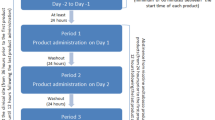Key Points
In brief
-
Zyban is a drug to aid smoking cessation
-
Oral side-effects include xerostomia
Abstract
Zyban is a drug, newly available on NHS prescription, to aid smoking cessation. Two clinical trials suggest superior efficacy to nicotine patches, however side-effects include xerostomia and its use may have an impact on oral health.
Similar content being viewed by others
Main
Cigarette smoking has a recognised impact on oral health as well as general health. All healthcare workers should be involved in encouraging smokers to break the habit and should be aware of new developments in this field. Zyban is a prescription only drug newly introduced as an aid to smoking cessation. The UK Medicine Control Agency has licensed Zyban for use as an aid to smoking cessation from June 2000 and the Department of Health has indicated that it will be a reimbursable prescription item with an NHS cost of £85.70 per 2-month treatment course. With the attendant publicity that the drug has received in the media, the demand for and usage of this drug is likely to increase rapidly and dentists may see increasing numbers of patients who are receiving this medication. The aim of this briefing paper is to describe the drug; its usage and implications for oral health.
Pharmacology.
Zyban is a non-nicotine drug manufactured by Glaxo Smithkline and supplied as a 150 mg sustained release tablet. The recommended maximum dosage for adults over 18 years is 150 mg daily for 3 days increasing to 150 mg twice daily for the remainder of the 7–9 week treatment course. It is advised that the drug be used as part of a programme of smoking cessation with counselling, support and regular monitoring. The active agent, bupropion hydrochloride, is also used in the anti-depressant drug Wellbutin which was introduced in the USA in an immediate– release form in 1989 and in a sustained release formulation in 1997. The apparent ability for the drug to assist in smoking cessation was an incidental finding during clinical practice among Vietnam war veterans in the USA. The mode of action on smoking addiction is unclear, but is possibly related to an effect on the dopamine and noradrenaline dependent neurochemical pathways in the brain responsible for nicotine dependency.
Clinical studies
The evidence for the efficacy of Zyban as an aid to smoking cessation is based on the findings of two clinical trials. The study by Hurt et al.1 compared Zyban at dosages of 100 mg, 150 mg and 300 mg daily with a placebo and found that the 300 mg group of 156 subjects showed significantly higher continuous abstinence rates throughout the 1-year study compared with the placebo group. The second study by Jorenby et al.,2 compared three treatment regimes: Zyban (n = 244), nicotine patches (n = 244) and the combination of Zyban and nicotine patch treatment (n = 244) with a placebo group (n = 160). Zyban alone or combined with nicotine patches gave a significantly higher level of continuous abstinence during the 12-month study compared with both the placebo and the nicotine patch group (all P < 0.001). All subjects in these studies were self-selected and smoked at least 15 cigarettes/day. A structured counselling programme accompanied treatment in each group. Self-reporting of abstinence was confirmed by a carbon monoxide level in exhaled air of 10 ppm or less. The results from this study are used by Glaxo Smithkline to promote Zyban and a success rate of 30% for Zyban compared with 16% for the placebo is quoted. These figures, based on the point abstinence data at 12 months, are more favourable than the continuous prevalence figures which some authorities believe are more meaningful.
Contra-indications and adverse affects
One positive effect is that Zyban appears to attenuate the weight gain normally associated with smoking cessation and there is evidence for this from both clinical trials. Bupropion is contraindicated for patients with a history of seizure (eg history of stroke, alcohol abuse, CNS tumour) bulimia, anorexia nervosa, severe hepatic cirrhosis, bipolar disorder and monoamine oxidase inhibitor therapy. The safety of bupropion in pregnancy is unknown and pregnant women should be encouraged to abstain without drug therapy.
While reports from clinical trials have generally indicated that Zyban is well tolerated, several adverse reaction reports are of relevance to oral health. Dry mouth affected 11% of subjects taking Zyban alone in the study by Jorenby et al.2 compared with 4% in the placebo group. Also significantly more common was insomnia. Hurt et al. found similar differences.1 In combination with nicotine patches, nausea was significantly more common affecting 11% of the combined therapy group. Allergic reactions to bupropion have been reported in 0.8% of patients compared with 0.3% of placebo patients, but severe reactions appear rare although there have been several reports of erythema multiforme and Stevens-Johnson syndrome.
The principal oral reaction appears to be dry mouth. In addition to causing discomfort with speech and mastication, reduced salivary flow is associated with increased caries risk and difficulty with oral hygiene. Patients taking Zyban may benefit from appropriate advice to reduce the associated risks.
Conclusion
The use of Zyban is likely to become common and oral health professionals should be aware of its benefit to oral health and the oral significance of its adverse effects.
References
Hurt R D et al. A comparison of sustained-release Bupropion and placebo for smoking cessation. New Eng J Med 1997; 337: 1195–1002.
Jorenby et al. A controlled trial of sustained-release Bupropion, a nicotine patch or both for smoking cessation. New Eng J Med 1999; 340: 685–691.
Acknowledgements
The author is grateful to Mrs Catherine Stillman-Lowe of the Health Development Agency and Dr D S Levine of Northwick Park Hospital, London for their assistance.
Author information
Authors and Affiliations
Corresponding author
Additional information
Refereed paper
Rights and permissions
About this article
Cite this article
Levine, R. Briefing paper – Zyban. Br Dent J 189, 412 (2000). https://doi.org/10.1038/sj.bdj.4800786
Received:
Accepted:
Published:
Issue Date:
DOI: https://doi.org/10.1038/sj.bdj.4800786



